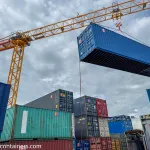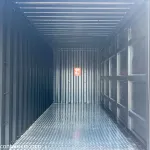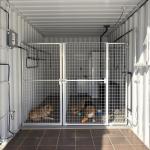Dimensions of shipping containers according to ISO classification
Shipping containers play a vital role in a globalized world where it is necessary to efficiently and safely transport goods between continents. The standardization of containers through the International Organization for Standardization (ISO) has enabled the smooth running of logistics processes across different means of transport. The ISO 668 standard defines the classification, dimensions and load capacity of so-called ISO class 1 containers, of which there are a total of six types (1A to 1F). However, the most widespread of them are types A and C, which you will encounter most often in practice. In this article, we will focus on a detailed description of these containers: 1C, 1CC, 1A, 1AA and 1AAA.
Overview of ISO 1 containers
ISO 1 containers are designed to enable efficient handling, stacking and transport by sea, rail and road. The division into types 1A to 1F is based on their length and height, which affects their capacity and possibilities of use. The standardization of these dimensions ensures compatibility between means of transport and minimizes complications when transferring goods.
Container types A and C
Type A and C containers are the most common in international transport. Type A includes 40-foot containers with a length of 12 meters, while Type C represents 20-foot containers with a length of 6 meters. These containers are the basis of global trade due to their versatility and adaptability to different types of cargo. That Type 1A is twice as long as Type 1C is no coincidence. This property allows them to stack with each other. The body of the container is made of solid metal and is designed for stacking up to 6 containers on top of each other as standard.
While the width is fixed, the length and height of the containers vary depending on the type. Base models designated as 1A and 1C have a standard height of 2438mm. However, there are also higher types such as 1AA and 1CC with a height of 2591 mm, and a large container 1AAA with a height of 2896 mm.
Detailed knowledge of the specifics of individual container types is key to effective logistics. The following description presents the technical parameters and use of containers 1C, 1CC, 1A, 1AA and 1AAA.

Container 1C
Technical specifications:
- External dimensions:
- Length: 6.058 m
- Width: 2.438 m
- Height: 2,438 m
- Internal dimensions:
- Length: approximately 5.898 m
- Width: 2.352 m
- Height: 2,352 m
- Capacity: approx. 30.9 m³
- Maximum gross weight: 24,000 kg – 26,500 kg
The 1C container is a low variant of the 20-foot container. The lower height of this container is suitable for transporting heavy goods with a smaller volume, such as metal ingots or heavy machine parts. A lower center of gravity improves stability during transport and stacking.
1CC container
Technical specifications:
- External dimensions:
- Length: 6.058 m
- Width: 2.438 m
- Height: 2,591 m
- Internal dimensions:
- Length: approximately 5.898 m
- Width: 2.352 m
- Height: 2,393 m
- Capacity: approx. 33.2 m³
- Maximum gross weight: 28,000 – 30,480 kg
The 1CC container, also known as the standard 20-foot container, is the most widely used type in sea shipping. It is ideal for transporting a wide range of goods, from consumer products to industrial materials. Its compact dimensions facilitate handling and enable the transport of heavy loads with a lower volume.
1CCC container
Technical specifications:
- External dimensions:
- Length: 6.058 m
- Width: 2.438 m
- Height: 2,896 m
- Internal dimensions:
- Length: approximately 5.898 m
- Width: 2.352 m
- Height: 2,698 m
- Capacity: approx. 37.4 m³
- Maximum gross weight: 28,500 – 30,480 kg
The 1CCC container, also known as the 20-foot High Cube container, is a frequently used type in sea transportation. It is ideal for transporting a wide range of goods, which provides a higher height. Its compact, taller dimensions make it easier to handle and allow the transport of bulkier loads with higher volume.

Container 1A
Technical specifications:
- External dimensions:
- Length: 12.192 m
- Width: 2.438 m
- Height: 2,438 m
- Internal dimensions:
- Length: approximately 12.032 m
- Width: 2.352 m
- Height: 2,352 m
- Capacity: approx. 66.4 m³
- Maximum gross weight: approx. 28,000 kg
The 1A container, known as a low 40-foot container (low cube), offers a reduced internal volume. It is ideal for transporting lower but heavier goods. A lower center of gravity improves stability during transport and stacking.
Container 1AA
Technical specifications:
- External dimensions:
- Length: 12.192 m
- Width: 2.438 m
- Height: 2,591 m
- Internal dimensions:
- Length: approximately 12.032 m
- Width: 2.352 m
- Height: 2,393 m
- Capacity: approx. 67.7 m³
- Maximum gross weight: 30,480 kg
The standard 40-foot container 1A is ideal for transporting larger volumes of goods. Thanks to its length, it is suitable for lighter but bulkier loads. It is often used in the transport of textiles, electronics, furniture and other consumer goods.
1AAA container
Technical specifications:
- External dimensions:
- Length: 12.192 m
- Width: 2.438 m
- Height: 2,896 m
- Internal dimensions:
- Length: approximately 12.032 m
- Width: 2.352 m
- Height: 2,698 m
- Capacity: approx. 76.4 m³
- Maximum gross weight: 30,480 kg
The 1AAA container, known as a high 40-foot container (high cube), offers increased internal volume due to its increased height. It is ideal for transporting bulky but light goods such as plastic products, clothes on hangers or furniture. Increased capacity enables better use of space and lowers costs per unit of transported volume.
Clear table of dimensions of ISO 1 containers:
| ISO 1 containers | length | height | width | |||||||
| [mm] | [stop] | [mm] | [stop] | [mm] | [stop] | |||||
| 1C | Low Cube | 6058 | 20 | 2438 | 8 | 2438 | 8 | |||
| 1CC | Standard | 6058 | 20 | 2591 | 8.5 | 2438 | 8 | |||
| 1CCC | High Cube | 6058 | 20 | 2896 | 9,5 | 2438 | 8 | |||
| 1A | Low Cube | 12192 | 40 | 2438 | 8 | 2438 | 8 | |||
| 1AA | Standard | 12192 | 40 | 2591 | 8.5 | 2438 | 8 | |||
| 1AAA | High Cube | 12192 | 40 | 2896 | 9.5 | 2438 | 8 | |||
.
The importance of choosing the right container
The right choice of container is crucial for efficient logistics and cost minimization. When choosing, it is necessary to consider:
- Dimensions and weight of the goods: Ensure that the goods correspond to the internal dimensions and that the maximum load capacity is not exceeded.
- Nature of the goods: Some materials may require special conditions such as moisture protection or temperature regulation.
- Loading efficiency: Optimizing the use of space can reduce transportation costs.
- Legal Restrictions: Some countries may have restrictions regarding the transportation of excess cargo or the use of certain types of containers.
Understanding the differences between individual container types enables better planning and can bring significant savings in the logistics chain.
DIMENSIONS OF SHIPPING CONTAINERS ACCORDING TO ISO 1
The standardization of shipping containers according to ISO 668 has made a significant contribution to the efficiency and safety of international transport. 1C, 1CC, 1A, 1AA and 1AAA containers are essential elements of global trade and their proper use is essential for successful logistics. By understanding their specifications and making the right choice, you can optimize transport processes, reduce costs and ensure that goods arrive at their destination on time and in good order.
When planning transport, it is therefore important to cooperate with logistics experts and carefully consider all the parameters of the goods as well as the requirements of the target markets. Choosing the right container is not only a question of dimensions, but also a strategic decision that can affect the overall success of a business operation.
Other container news...
By buying a container directly from the shipping company, you save hundreds of €
Buying a container directly from a shipper is the ideal choice for those looking for quality, reliability and economy. The process is simple, transparent and allows you to choose a container to suit your needs. Plus, you get the reassurance that you are working directly with a trusted source, minimizing the risk of any complications.
What to do if the container does not match the condition and quality we ordered?
Are you picking up a shipping container at a warehouse depot and worried that you’ll get a worse piece than you ordered? Your fears can go away because the guarantee of type, size and condition is subject to strict standards. You may not be familiar with these standards, but they are the standard for all those who deal in containers. IICL6, IICL5, Cargo Worthy and AS IS all have clearly defined condition.
Frauds in the purchase of shipping containers
Container scammers… that’s a topic that’s already blown up. Worse, it just keeps going on and on and people don’t learn. How do you prevent these situations, how do you protect yourself and how do you spot a scam? That’s what we’re going to tell you in our article…
Shipping container for dogs
Shipping containers can be used for a variety of purposes. Nowadays, they are also widely used for dogs, whether for transport purposes for the military, travel abroad or as a use for shelters or guard stations. Read more about the possibilities in the article.



